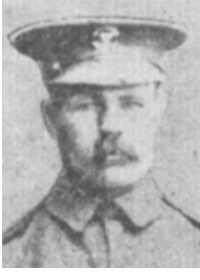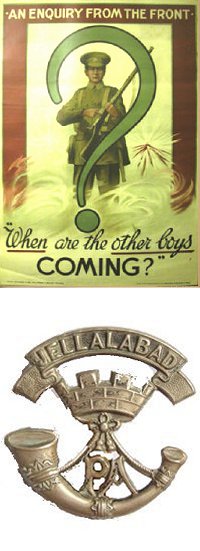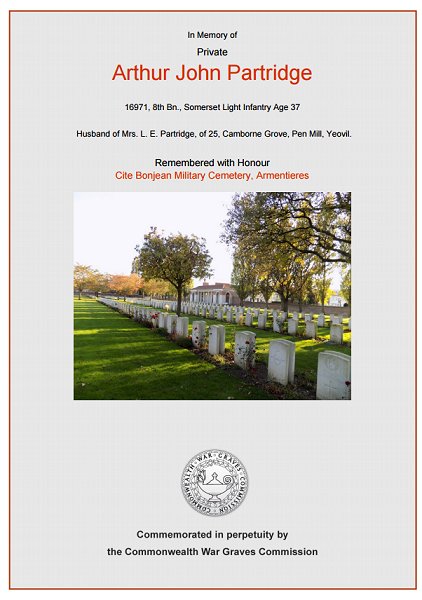yeovil at War
Arthur John partridge
Died of 'shell shock' on the Western Front
 Arthur George
Partridge was
born in 1880 at
Hardington
Mandeville,
Somerset, the
son of labourer
John Partridge
(b1855) and
Charlotte née
Delamont
(b1854), both of
Hardington. In
the 1881 census
John and
Charlotte were
listed in
Hardington with
their children;
Jane (b1875),
Albert (b1876)
and one-year old
Arthur. The
family were
still in the
village in 1891
but with four
more children;
George (b1882),
Elizabeth
(b1884), Sydney
(b1886) and
Percy (b1887).
Both John and
11-year old
Arthur gave
their
occupations as
labourers.
Arthur George
Partridge was
born in 1880 at
Hardington
Mandeville,
Somerset, the
son of labourer
John Partridge
(b1855) and
Charlotte née
Delamont
(b1854), both of
Hardington. In
the 1881 census
John and
Charlotte were
listed in
Hardington with
their children;
Jane (b1875),
Albert (b1876)
and one-year old
Arthur. The
family were
still in the
village in 1891
but with four
more children;
George (b1882),
Elizabeth
(b1884), Sydney
(b1886) and
Percy (b1887).
Both John and
11-year old
Arthur gave
their
occupations as
labourers.
In the winter of 1899, at the age of 19, Arthur married Lucy Ellen Sims (b1878, Newport, Wales) at Yeovil. They set up home at 34 Great Western Terrace and were listed there in the 1901 census with their four month-old son Wilfred. Arthur gave his occupation as an Assurance Agent. Arthur and Lucy were to have another child but I could not trace them in the 1911 census. They did, however, move to 27 Camborne Grove at some stage.
 Arthur
enlisted at
Taunton in
January 1915,
joining 8th
(Service)
Battalion,
Somerset Light
Infantry. His
Service Number
was 16971.
Arthur
enlisted at
Taunton in
January 1915,
joining 8th
(Service)
Battalion,
Somerset Light
Infantry. His
Service Number
was 16971.
The 8th (Service) Battalion was formed at Taunton on 20 October 1914 and came under command of 63rd Brigade, 21st Division. The battalion, including Arthur, went to France on 10 September 1915, landing at Le Havre.
On 25 September 1915, the 6th, 7th and 8th Battalions of the Somersets became embroiled in the Battle of Loos - the British Army's contribution to the major Allied offensive launched simultaneously with the main French offensive in Champagne. It was the biggest British attack of 1915.
A continuous preliminary bombardment, which showered 250,000 shells on to the German defences over four days, had little real effect. Before sending in the infantry on the morning of 25 September 1915, the British released 140 tons of chlorine gas from 5,000 cylinders placed on the front line to make up for the ineffective artillery barrage. This was the first time the Allies had used the weapon, coming after the Germans employed gas to terrible effect at Ypres in April earlier in the year, and it was hoped it would annihilate the Germans at Loos. However a change in the direction of the wind at several points along the front blew the gas back into the British trenches, causing seven deaths and injuring 2,600 soldiers who had to be withdrawn from the front line. Initially the gas attack created panic among the Germans and close to 600 men were gassed. Despite the setbacks caused by the wind 75,000 British infantrymen still flowed out from the trenches when the order came. British losses at Loos were exceptionally high with 50,000 casualties, including at least 20,000 deaths.
Following the Battle of Loos, the 21st Division suffered over 3,800 casualties and took the rest of the year to rebuild. As winter set in the intensity of fighting lessened somewhat although the landscape remained extremely dangerous and day-to-day fighting in the trenches took a tremendous toll on both sides. At the end of January 1916 Arthur was caught in the blast of a shell exploding near him. Although "affected by the shock of a shell falling near him; he was not hit in any way, and was conscious to the last" nevertheless Arthur must have sustained serious internal injuries from the blast as he died on 27 January 1916.
In its edition of 11 February 1916 the Western Gazette reported "Another Yeovilian to meet his death in action is Private AJ Partridge, who is reported to have died on January 27th from shell shock received whilst serving in the trenches with the 8th Somersets. His widow, who resides at 27 Camborne Grove, and is left with two children, has received many letters of sympathy, including one from the Wesleyan chaplain, who officiated at the burial of the deceased, and one from the late Private’s comrade, both of whom pay warm tribute to his conduct in the trenches. Describing how the deceased met his death, the Wesleyan chaplain said that he was affected by the shock of a shell falling near him; he was not hit in any way, and was conscious to the last. The late Private Partridge gave up his employment at Messrs. Lock’s to enlist in January 1915, and went to the Front in September of the same year."
Arthur Partridge was interred in Cite Bonjean Military Cemetery, Armentieres, France. Grave IX.E.52, and his name is recorded on the War Memorial in the Borough.
gallery

The Commonwealth War Graves Commission certificate in memory of Arthur Partridge.